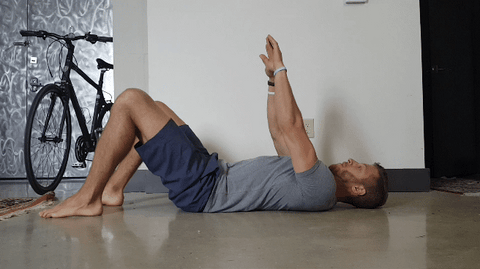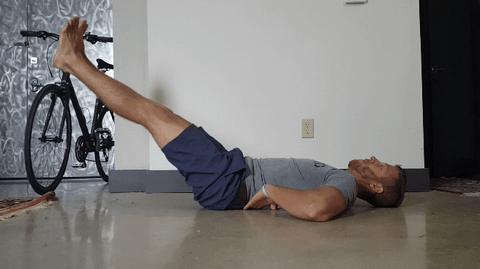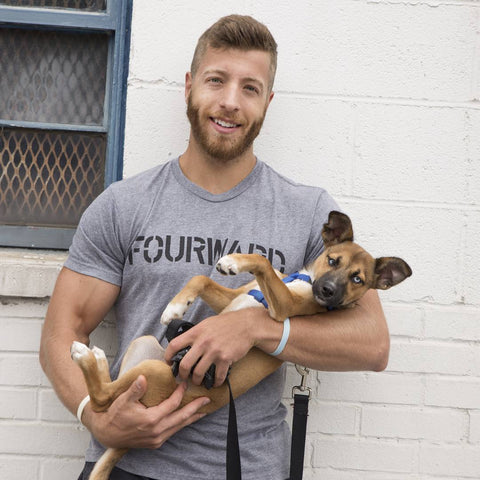Boly below in our Fourward Signature Tee (coming soon)
With Strength Coach Jake Boly
A strong core is like the holy grail of fitness training: everyone wants one, but few know how to properly build one. To shed light on the mystery, we teamed up with writer, editor and strength coach Jake Boly for his top rules and exercises for training a stronger and more balanced core.
Rule 1: Get Your Alignment Right
One of the most common mistakes made with core training is torso positioning. If you’re arching your lower back or overusing your hips, you may be disengaging your core, rendering the whole exercise useless. Luckily, fixing your alignment is relatively easy.
Start by lying down, placing a resistance band under your lower back. The key here is to have your lower back flush with the floor. This will trigger your ab muscles to do the work, as opposed to shifting your weight into your back or hips. To make sure this is happening, squeeze your abs and check that your lower back stays in position. Once you’ve applied pressure onto the band, pull it up as if you’re trying to pull it from under your back. If you’re able to squeeze your core and hold the band in place, then you’re engaging the proper ab musculature.
Correct Alignment:

Incorrect Alignment:

Rule 2: Don’t Wait to Exhale
It’s easy to forget about breathing when in the middle of training. While lifting, most of us follow what’s called the valsava maneuver. This technique involves an inhale through concentric portions (lifting phases), and an exhale through eccentric portions (lowering phases). For compound, or heavier lifts, this breathing technique is great - but there’s a big problem when it comes to training the core.
A torso full of air increases pressure and rigidity, which is excellent for standing exercises. But because it also limits how much the stomach muscles can contract, it can throw a big wrench into core training. For this reason, it’s important to reverse your breathing technique when working the core. Rather than follow the valsava maneuver, exhale through the concentric phases and inhale through the eccentrics. For example, if you’re doing a hanging leg lift, exhale as you bring the legs up and inhale when you bring them down.
Rule 3: Tempo Is Your Friend
OK, “tempo”, or how you pace your reps, isn’t exactly a rule, but it’s a great core training modality. The core is composed of smaller muscles groups that can be trained at higher frequencies and volumes. A lot of people fly through their core sets and call it a day, but going through a bunch of reps with haphazard speed isn’t an optimal way to train these muscles.
Tempo is an easy tool to use when trying to track core strength and progress. A great technique is counting out different phases of a movement, then trying to increase, or improve upon that in the next workout. For example, let’s say you’re doing hanging leg raises. You could use tempo by doing a 3-second leg raise, a 1-second hold, then a 2-second lowering phase, and then adding seconds to your reps the next time you repeat the same exercise.
And now for the exercises...
Exercise 1: Upper Ab Extended Arms Crunch

This movement is simple, but super-effective for the upper core. Studies have shown it’s among the top things you can do for strictly stimulating upper ab muscles. To begin, lie on your back with your feet planted and knees bent at 90 degrees. Extend your arms in front of you, squeeze the core (driving the lower back into the ground), and crunch by only lifting your upper back off the ground. As you perform this movement, think about only using the upper ab musculature, and hold it for a second or two at the top. Increase the length of the hold as you build up strength.
Exercise 2: Lower Leg Crunch

The next movement I like to use is for the lower abs. A lot of people have trouble with isolating the lower core without overly using their hips, and arching the lower back. There are two things I do to prevent this. One, place the tips of your fingers slightly under your lower back, and press into them. Two, as you bring your legs in and extend them, stop slightly higher than you normally would. This is often a better progression for those who are strictly trying to target the lower abs, and don’t have the starting strength to bring their feet lower.
Exercise 3: Deadbugs

One of my favorite full core movements is the deadbug. It requires coordination, tempo, and breathing focus. To begin, lie on your back and bring one leg to your chest, then your diagonal arm straight up (example: right leg up, left arm up). Next, extend that leg while simultaneously bringing the other up, and do the same with the arm. Think of the motion as though you’re switching positions from the first diagonal positioning to the next.
Breathe out when switching positions. Then, take a breath in, and breathe out when moving your limbs again. This exercise is great to do with a 3-4 second tempo between each switch, as it ensure you’re driving the back down by engaging the core and breathing correctly.
Working your core right won't just produce visible results for your abs, it will increase your strength in all training areas. There's no better reason to Start Before You're Ready ®.

Jake Boly is a fitness editor for BarBend, and runs his personal training business Concrete Athletics on the side. He's a certified strength and conditioning specialist (CSCS) with a Masters in Sports Science and a Bachelors in Exercise Science. Find him at @jake_boly on Instagram.
